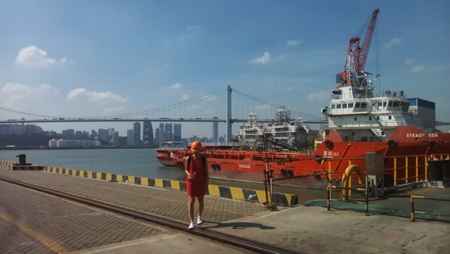

As early as 2,000 years ago, ships were leaving the various ports in east China’s present day Fujian province sailing westwards. Navigating rough seas, the ships carried Chinese silk, porcelain, lacquerwork and ironware, white pepper, flax, spices, grape and pomegranate to the world market- using sea routes which came to be known as the maritime Silk Road.
The port of Quanzhou

Along with Ningbo, Guangzhou, Beihai, Colombo, Jeddah and Alexandria, Quanzhou is another of the ancient ports along the maritime Silk Road. In the Tang dynasty (618-907 AD), Quanzhou was one of the four largest seaports for foreign trade in China. In the Song and Yuan dynasties, Quanzhou (then renamed Zayton Ports)'s influence even grew bigger, earning the title of the world’s largest Oriental Port.
Because of its strategic position in the ancient maritime Silk Road, Quanzhou easily became the centre of multiculturalism, aiding the spread of Buddhism in China and Southeast Asia. Confucianism, which was born in China, gained appreciation by European thinkers such as Leibniz and Voltaire. As a modern port, Quanzhou has maintained its tradition of facilitating people to people exchanges, a key component of the Belt and Road Initiative. Today, 9.48 million overseas Chinese in 130 countries and regions trace their origin back to Quanzhou, 90% of whom live in countries along the maritime Silk Road.

The Kaiyuan temple pagoda in Quanzhou survived a very powerful earthquake 400 years ago
Today, Quanzhou is one of the largest cities in Fujian province with a population of over 8 million. Under the vision of the Belt and Road, the city is the pilot zone for the 21st Century Maritime Silk Road as well as the strategic pivot of maritime cooperation.

The Xiamen ship building yard. Fujian province is embracing emerging industries for the 21st Century Maritime Silk Road (Ronald Kato)
Smaller but equally significant ports
Anhai port
Anhai, serving as the hub of land and sea between Jinjiang and Nan’an, was one of the most important ports for overseas transportation for Quanzhou in Song and Yuan dynasties. At that time, Quanzhou attracted many commercial ships from all over the world, witnessing merchants from all over the world coming to Quanzhou.
Dongshi port
In the Ming dynasty, Dongshi was used mainly by private business ships to dock. Because of Dongshi’s popularity, an old adage goes that Anhai is a good passage for businessmen while Dongshi is best for ships.
Fuquan port
Fuquan is located in the Weitou peninsula of Jinjing village. Historically, Fuquan was a commercial port and a military fortress to defend the southeast against aggression.
Shenhu port
Located in the Shenhu bay, the port is of strategic importance. Across the sea stands Yongning port to the north. In Yuan dynasty, Shenhu was the base of the coast guards to fight piracy. In the Ming dynasty, Shenhu was a military defence hub for Quanzhou.
Jinjiang city
Following the unveiling of the Belt and Road Initiative by President Xi Jinping in 2013, Jinjiang city was incorporated into the 21st Century Maritime Silk Road. The city aims to transform into a smart, eco-friendly metropolis leading in innovation in Southeast China.
Jinjiang is also looking at diversifying from the main traditional industries of textile and apparel, shoe making, building materials and ceramics, food and beverage to emerging industries such as new materials, photovoltaic technology, marine biotechnology, intelligent equipment and automobile parts manufacturing.
As more countries along the Maritime Silk Road aim to transform their economies from agriculture to industry, Jinjiang is poised to provide crucial lessons.
Technology powering development, shared benefits
In Xiamen, the host city for this year’s BRICS summit, a tech company- Meitu is looking at taking advantage of the Belt and Road Initiative to venture west wars into Africa and Europe. Pursuing innovation-driven development is a key target of the Belt and Road Initiative. The initiative aims to intensify cooperation in frontier areas such as digital economy, artificial intelligence, nanotechnology and quantum computing, and advance the development of big data, cloud computing and smart cities so as to turn them into a digital Silk Road of the 21st century.

Born in Xiamen, Meitu is in the same league as other tech giants Google and Facebook (Ronald Kato)
As part of its 10 year vision, Xiamen is looking at establishing a science and technology park to diversify from traditional industries such as ship building. The park will be used as an incubation centre for tech ideas and start-ups needed to transform economies of countries in the Belt and Road Initiative.

As China’s economy transitions from manufacturing to one powered by services and innovation, countries in the Belt and Road will be getting ready to reap benefits.
Ronald Kato is a journalist and broadcaster with Vision Group in Kampala, Uganda. He is currently doing his internship training at China Global Television Network (CGTN)
 Fire brigade in Shanghai holds group wedding
Fire brigade in Shanghai holds group wedding Tourists enjoy ice sculptures in Datan Town, north China
Tourists enjoy ice sculptures in Datan Town, north China Sunset scenery of Dayan Pagoda in Xi'an
Sunset scenery of Dayan Pagoda in Xi'an Tourists have fun at scenic spot in Nanlong Town, NW China
Tourists have fun at scenic spot in Nanlong Town, NW China Harbin attracts tourists by making best use of ice in winter
Harbin attracts tourists by making best use of ice in winter In pics: FIS Alpine Ski Women's World Cup Slalom
In pics: FIS Alpine Ski Women's World Cup Slalom Black-necked cranes rest at reservoir in Lhunzhub County, Lhasa
Black-necked cranes rest at reservoir in Lhunzhub County, Lhasa China's FAST telescope will be available to foreign scientists in April
China's FAST telescope will be available to foreign scientists in April "She power" plays indispensable role in poverty alleviation
"She power" plays indispensable role in poverty alleviation Top 10 world news events of People's Daily in 2020
Top 10 world news events of People's Daily in 2020 Top 10 China news events of People's Daily in 2020
Top 10 China news events of People's Daily in 2020 Top 10 media buzzwords of 2020
Top 10 media buzzwords of 2020 Year-ender:10 major tourism stories of 2020
Year-ender:10 major tourism stories of 2020 No interference in Venezuelan issues
No interference in Venezuelan issues
 Biz prepares for trade spat
Biz prepares for trade spat
 Broadcasting Continent
Broadcasting Continent Australia wins Chinese CEOs as US loses
Australia wins Chinese CEOs as US loses